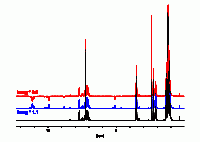[Uni Tübingen] - [Mat.-Nat. Fakultät] - [Fachbereich Chemie] - [Anorg. Chemie] - [Klaus Eichele] - [NMR Ramblings] - [NMR Panopticum] - Quadrature Detection Image
 |
NMR Panopticum: |
A quadrature detection image will appear if the two channels of the receiver are electronically imbalanced. The so called quad image can be identified by looking at the strongest peak in the spectrum, measuring its separation from the transmitter frequency (the exact center of the spectrum), and going the same distance from the center to the other side of the spectrum. This is the place where the quad image will appear. If there are real peaks in this area, the phase of the quad image and the real peaks will be different. However, if there are no real peaks around one can often phase properly the originating peak and its artefact.
There are three general causes of this quad image:
- differences in the gains of the audio frequency amplifiers of the two channels,
- direct current offsets from the amplifiers,
- deviation from the exact 90 degree phase shift of the two reference signals to the phase sensitive detector.
The CYCLOPS phase cycling is designed to reduce or eliminate quad images, therefore increasing the number of scans to at least one full phase cycle should eliminate the quad image. Also consider that the phase cycling works best if each scan contributes approximately the same intensity, therefore a few dummy scans before the actual measurement to achieve a steady state could be helpful.
[ Anorg. Chemie ] | [ Go Home ] | webm@ster | last modified: 20.03.2020


